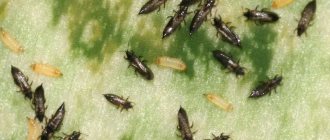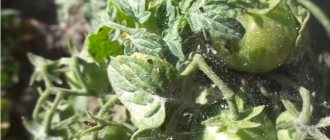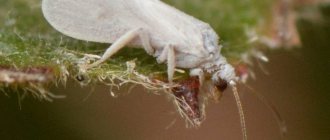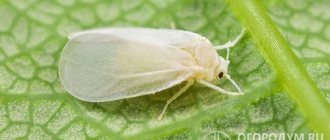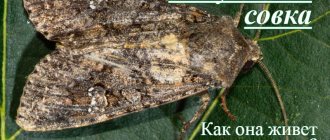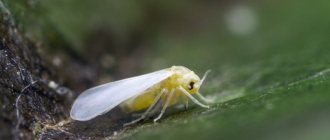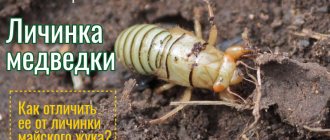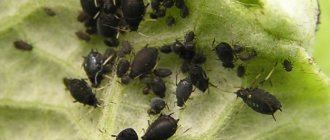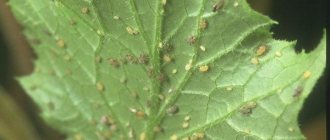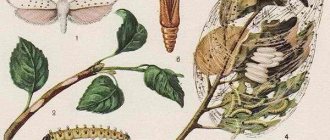One of the most insidious garden pests is the whitefly. This small insect, whose length does not exceed 2.5 mm, is distinguished by its exceptional ability to reproduce. Voracious insects are capable of completely destroying cultivated plants growing in closed ground.
And if the heat-loving whitefly needs a fairly high ambient temperature to exist in the open air, then in greenhouses and greenhouses it can exist all year round, causing irreparable harm to greenhouse plants.
How to deal with whitefly in a greenhouse
Biological description of the pest
Many types of whiteflies are similar in appearance and have the same development cycle. In temperate climates, cabbage whitefly can most often be found on garden crops.
And in greenhouses and hothouses, almost everywhere, the greenhouse whitefly is found. It harms many protected soil crops: tomatoes, cucumbers, peppers, herbs and others. Due to the adaptability of feeding on various crops, it is a polyphage.
Description
The body of an adult insect is very small, no more than 2 mm in length, with a width from 0.3 to 0.7 mm. The color is light, yellowish with noticeable dark spots on the sides of the head, chest and abdomen. The number of wings is 4. Their surface is covered with a whitish, flour-like coating, and the body of the pest is also covered with it. It was he who gave the name to these insects. At rest, the wings are folded at an angle.
Mustache
A pair of antennae extend from the front of the head. The first two segments are spherical, the next five segments are thin and long. There is a hair on the last one.
On the third, fifth and seventh segments there are special sensory organs or rhinaria. In whiteflies they are small, round with numerous cilia.
Other organs
Whiteflies have a pair of eyes. They are complex with a constriction that divides them into dorsal and ventral parts. The mouthparts or proboscis are of the piercing-sucking type.
The insect has six long legs. On the second segment there is an unpaired outgrowth or paronychia.
At the end of the body you can find the anus. It is located on the dorsal side. It looks like a cup with a tongue inside, covered with a lid.
The whitefly has four pairs of spiracles that open outward. Two on the abdomen and chest. They serve to bring air into the trachea of the insect.
Sexual dimorphism
Females differ from males in the structure of their genital organs. Females have an ovipositor at the end of their abdomen. It looks like a thin chitinous tube that is used for laying eggs.
Males have a copulatory organ on the last abdominal segment. It is needed for copulation with females.
Advantages and disadvantages of insecticides
Advantages:
- A large selection of drugs on the market at different prices and different mechanisms of action on pests;
- Most chemicals effectively destroy both adult pests and their offspring;
- Some preparations have fumigator properties, that is, they form a protective cloud around the plant.
Flaws:
- Some chemicals can cause serious harm to the natural enemies of whiteflies;
- When using agrochemicals, you must follow safety rules and wear a mask, goggles and gloves;
- Some insecticides are quite expensive.
Life cycle
All stages of the pest can go through the winter, but most often it is experienced by adult insects and larvae at the stage of puparia - false cocoon. The life cycle of whiteflies has 6 stages of development:
- Egg. The first years of insects can be observed in late May - early June. They lay eggs on the underside of leaves. The masonry looks like a ring or half ring. The eggs are small, no more than 0.2 mm in length, at first they are light yellow, darkening over time. They have a stalk at the upper end. With its help, the eggs are attached to the plant. The duration of the stage is 3 – 9 days.
- Larva of the first instar. The stage lasts from 2 to 6 hours. The larva is mobile, light-colored, covered with a waxy coating on top. She moves around, looking for a place to feed, which is why she is called a tramp or a creeper.
- Larva of the second instar. The stage lasts up to 4–5 days, the limbs and antennae are shortened, and mobility is lost.
- Larva of the third instar. At this stage, the antennae and limbs practically atrophy. The larva is motionless.
- Larvae of the fourth instar. After 4–5 days, the larva becomes like an oval-shaped wax capsule surrounded by a ring of wax spikes. This stage is called the false pupa or puparia. They are light, up to 1.2 mm long, up to 0.7 mm wide. In autumn they change color to dark. The stage lasts up to 9 days. At this time, the legs, wings, antennae and other organs of an adult insect are formed inside the wax cocoon, and the body acquires volume. Just before exiting the puparia, feeding stops.
- Imago. 10 – 12 hours after leaving the cocoon it is ready to mate. After 2–3 days, the female begins to lay eggs and the cycle repeats. Its average duration ranges from 20 to 40 days.
Fertility
In temperate climates, whiteflies produce from 1 to 3 generations. In the south or in a greenhouse they reproduce year-round. The number of eggs produced by one adult female depends on the ambient temperature.
The most favorable temperature is + 20 degrees Celsius. Under these conditions, the number of eggs laid by one female is 210–230. If the air does not warm up above 15 - 16 degrees, then one female lays from 30 to 150 eggs. The lifespan of adults varies from several days to one and a half to two months. Females are more durable than males.
Which plants does it parasitize?
The greenhouse whitefly harms many indoor vegetable crops: tomatoes, cucumbers, peppers, and is also found on greens and flowers. And if it is not possible to take a break from growing and freezing the room in winter, it is very difficult to fight insects.
Cabbage whitefly primarily harms cabbage and vegetables from the Cruciferous family. Found on other vegetables and herbaceous plants. Closely related species parasitize berry and fruit plantations, nightshade crops and cotton.
Dangerous for flowers and ornamental plants. Settles on medicinal herbs. In total, up to 30 species of whiteflies are found in the Russian Federation and CIS countries.
What is the danger of a pest for plants and crop loss?
Whiteflies are dangerous for the plant primarily because they disrupt the nutrition of the green parts, sucking out their juice. Single specimens do not cause much harm, but an overgrown colony of whiteflies negatively affects the process of photosynthesis and respiration. Normal vegetation is disrupted, damage and drying out of leaf plates and other above-ground parts of the plant occurs.
The pest feeds at all stages except the egg and before the end of the puparium stage. Whiteflies are carriers of 60 species of plant viral pathogens.
With a slight spread of whiteflies, no more than 15–20% of host plants die. In advanced cases, you can lose 50–60% of the harvest of vegetables, berries and other crops.
Fungal diseases develop on plants from droppings and honeydew (sugary) secretions of insects. From which the loss of crops in protected soil can be up to 100%.
What is the danger?
This insect does not feed on the leaves themselves, but on the juice contained inside . As a result, the plant begins to quickly lose its vitality, the leaves become discolored, dry out, and the stems become brittle. And so on until complete death. In addition, the whitefly consumes too much liquid, and secretes some of it back, covering the leaves with a sticky coating, favorable for the development of various fungi.
The danger of whiteflies is that they reproduce extremely quickly; it is difficult to control their population in a greenhouse after infection. And the insect lays its eggs on the inside of the leaves, where they are difficult to see and remove.
Symptoms of plant damage
The threat to plants can be noticed even during the period of mass flight of adults. If you pay attention in time to small whitish butterflies swarming near plants, then you can already take measures to destroy them.
Once on the plant, the females quickly move to the underside of the leaves. They can be detected by shaking the plant and causing the pest to fly up.
When there is a large accumulation of adult insects and larvae, lightened areas become noticeable on the upper side of the leaf, which gradually darken.
As the number of whiteflies increases, the plant appears sticky. This is due to the fact that adults and larvae secrete substances similar to sugar syrup. They are called honeydew or honeydew.
Pathogenic sooty fungi or mobs settle on it almost immediately. The leaves turn black and photosynthesis stops, which causes the entire plant to dry out and die.
What do we know about greenhouse aleurodide?
There are more than one and a half thousand known species of Aleyrodidae. In Europe, in particular, there are about 20 species, including such “honored” pests as:
- citrus aleurodes (Dialeurodes citri, in Russia found in the Caucasus);
- tobacco (Bemisia tabaci);
- cabbage (Aleurodes brassicae);
- strawberry pest Aleurodes fragariae.
In this article we will look at only one species of whitewing - the greenhouse, or Trialeurodes vaporariorum, which “hunts” cucumbers, tomatoes, eggplants and readily feeds on flower plants.
The ideal habitats for Trialeurodes vaporariorum are warm and humid (greenhouses, greenhouses, residential apartments, closed loggias and balconies). The larvae of this miniature pest must be noticed in time: in favorable conditions, the insect multiplies rapidly, laying about two hundred eggs in each cycle.
The general algorithm for combating greenhouse whitefly is quite simple - the main thing is to detect its presence on plants in time, and then:
- manually remove larvae from leaves (so-called mechanical removal);
- treat plants with protective drugs (chemical insecticides or folk remedies);
- carry out correct preventive measures regularly.
If the invasion is not noticed in time, confrontation will require significant efforts and the use of chemical insecticides.
Means for fighting
When starting the fight against whiteflies, it is important to take into account the fact that insects at all stages of their development are simultaneously found on the plant. It will be necessary to use either one remedy that acts on adults, eggs and larvae of all ages, or to use two or three methods of control at once. The most difficult thing to destroy is the eggs of the pest, since they are covered with a dense waxy shell and do not feed.
Chemicals
When whiteflies are detected on plants, the plants are sprayed with neonicotinoids, organophosphorus compounds, pyrethroids, and chitin synthesis inhibitors. The use of chemicals with adhesives is recommended.
The most effective drugs against whiteflies:
Aktara, VDG. Manufacturer: Syngenta. The drug belongs to the chemical class neonicotenoids. Has a hazard class 3 for humans and a hazard class 1 for bees. Aktara is an insecticide with enteric contact action against leaf-eating and sucking pests of vegetables, grains and other crops. It has a number of advantages, including: speed, low consumption, efficiency in difficult weather conditions and a number of others.
Movento Energy, KS. Active ingredients: Imidacloprid 120 g/l, Spirotetramat 120 g/l. Preparative form: suspension concentrate. The drug belongs to the 3rd class of danger for humans and the 1st class for bees. Manufacturer: Bayer. Systemic unique insecticide with contact-intestinal action against sucking and gnawing pests. Destroys even secretive insects. A drug with many unique actions against pests, including: penetration into hard-to-reach places of plants, long-term protection (up to a month), meets food safety requirements, and is used against a wide range of pests.
Plenum, VDG. Active ingredient: Pymetrozine 500 g/kg. Preparative form: Water-dispersible granules. Hazard classes for humans and bees: 3. The unique mechanism of action virtually eliminates the occurrence of cross-resistance. Low danger to bees and safe for entomophages. Works well at high temperatures. Starts to act quickly.
Fufanon Expert, VE. Manufacturer: Keminovo The drug belongs to the chemical class of organophosphorus compounds. It contains the substance malathion (440 g/liter). This aqueous emulsion belongs to hazard class 3 for humans and 1 for bees. Fufanon Expert is an effective insectoacaricide. It protects plants not only from whiteflies, aphids, but also from some types of mites.
Iskra M, KE. Manufacturer: Technoexport. Hazard class for humans: 3. Hazard class for bees: 1. The active substance is the same as in the previous drug malathion, only in a different concentration (525 g/liter). The chemical protection agent has a wide spectrum of action and is used to protect against pests on almost all agricultural crops and forests. Iskra M is effective against whiteflies, aphids, caterpillars, leafhoppers, plant mites and many other gnawing and sucking insects.
Confidor Extra. Active ingredient: imidacloprid. Hazard class for humans: 3. Hazard class for bees: 1. Available in the form of water-dispersed granules in 1 g bags. Effectively used on nightshade, melon, cabbage, grain, and flower crops. It is used in open and closed ground. Pests die not only when they eat plants treated with the drug, but also when its solution gets on them. “Confidor Extra” causes blocking of vital receptors, paralysis and death of pests in the first two to three hours. The product is resistant to washing off by rain. Effectiveness lasts from 15 to 30 days.
More drugs: Alatar CE, Admiral, CE, Clipper, CE, Mospilan, RP, Biotlin Bau, VR, Inta-Vir, TAB
Table: Instructions for some drugs used against whiteflies
| Drug, hazard class for humans/bees | Norm | Culture | Harmful object | Method, processing time and features | Waiting period (number of treatments) | Output deadlines for manual (mechanized ) work |
| Aktara 3/1 | 0,8 | Protected soil tomato | Aphids, whitefly | Application under the root during drip irrigation. Plant height is more than 1 m. Working fluid consumption - 2500-5000 l/ha | 3(1) | 7(3) |
| 0,4 | Protected soil tomato | Aphids, whitefly | Application under the root during drip irrigation. Plant height is more than 1 m. Working fluid consumption - 2500-5000 l/ha | 3(1) | 7(3) | |
| 0,4 | Open ground tomato | Greenhouse whitefly, aphids, Colorado potato beetle | Application under the root during drip irrigation. Working fluid consumption - 2500-5000 l/ha | 3(1) | 7(3) | |
| 0,8 | Protected soil cucumber | Aphids, tobacco thrips, whitefly | Application under the root during drip irrigation. Plant height is more than 1 m. Working fluid consumption - 2500-5000 l/ha | 3(1) | 7(3) | |
| 0,4 | Protected soil cucumber | Aphids, tobacco thrips, whitefly | Application under the root during drip irrigation. Plant height is less than 1 m. Working fluid consumption – 2500-5000 l/ha | 3(1) | 7(3) | |
| 0,5 | Potted flower crops | Greenhouse whitefly, scale insects and false scale insects | Spraying during the growing season. Working fluid consumption – 500-2000 l/ha (concentration – 0.05%) | -(3) | 7(3) | |
| 0,9 | Flower crops in open and protected ground, flower seedlings | Aphids, whiteflies, thrips, scale insects and false scale insects | Watering the soil under the plants. Working fluid consumption – 100 l/100 m2 | -(1) | 7(3) | |
| Movento Energy 3/1 | 0,4−1,2 | Protected soil tomato | Greenhouse whitefly, thrips, aphids | Spraying during the growing season at a concentration of 0.04-0.05% (greenhouse whitefly, aphids), at a concentration of 0.04-0.06% (thrips). Working fluid consumption is 1000-3000 l/ha. | 3(2 | 1(-) |
| 0,4-0,6 | Protected soil cucumber | Greenhouse whitefly, thrips, aphids | Spraying during the growing season at a concentration of 0.04-0.05% (greenhouse whitefly, aphids), at a concentration of 0.04-0.06% (thrips). Working fluid consumption is 1000-3000 l/ha. | 3(2 | 1(-) | |
| Fufanon Expert 1/3 | 1,15 | Strawberries | Whitefly, raspberry-strawberry weevil, sawflies, strawberry mite | Spraying during the growing season. Working fluid consumption - 300-500 l/ha | 20(2) | 10(3) |
| 0,8-1,6 | Cabbage | Whiteflies, cabbage cutworms, moths, aphids, thrips, whitefly | Spraying during the growing season. Working fluid consumption - 200-400 l/ha | 20(2) | 10(3) | |
| 0,8-1,6 | Open ground cucumber | Mites, sprout fly, aphids, thrips, whitefly | Spraying during the growing season. Working fluid consumption - 200-400 l/ha | 20(2) | 10(3) | |
| 0,8-1,6 | Open ground tomato | Mites, aphids, whitefly | Spraying during the growing season. Working fluid consumption - 200-400 l/ha | 20(2) | 10(3) | |
| 1,5-4,5 | Protected soil cucumber | Mites, thrips, greenhouse whitefly | Spraying during the growing season. Working fluid consumption - 1000-3000 l/ha | 1(1) | 3(-) | |
| 1,5-4,5 | Protected soil tomato | Mites, thrips, greenhouse whitefly, nightshade leaf miner | Spraying during the growing season. Working fluid consumption - 1000-3000 l/ha | 1(1) | 3(-) | |
| Admiral, CE 3/3 | 0,2-0,3 | Protected soil tomato and cucumber | Greenhouse whitefly | Spraying during the growing season. Working fluid consumption – 1000-3000 l/ha | 3(1) | 7(2) |
| Mospilan, RP 3/3 | 0,15-0,2 | Protected soil tomato and cucumber | Greenhouse whitefly | Spraying during the growing season. Working fluid consumption – 1000-3000 l/ha | 1(1) | 3(3) |
| Confidor Extra, 3/1 | 0,15-0,45 | Protected soil cucumber | Greenhouse whitefly | Spraying during the growing season at a concentration of 0.015%. Working fluid consumption - 1000-3000 l/ha | 3(1) | 1(-) |
| 0,4 | Protected soil tomato | Greenhouse whitefly | Application under the root with drip irrigation or dosed root application. Plant height more than 1 m | 3(1) | 1(-) | |
| 0,15-0,45 | Protected soil tomato | Greenhouse whitefly | Spraying during the growing season at a concentration of 0.015%. Working fluid consumption - 1000-3000 l/ha | 3(1) | 1(-) |
* The instructions are not shown in full, but only sections with pests, one of which is whitefly.
Biological agents
Biological preparations can be used to effectively destroy whiteflies on various plants in open and closed ground. Their action is based on the natural enemies of the insect:
- Biovir. Mycological preparation for protecting plants from pests. The drug contains spores of the fungus – entomopathogen Verticillium lecanii. The fungus disrupts the life processes of whiteflies, including interfering with feeding and egg laying. Capable of destroying up to 80% of the colony. The development of eggs and larvae of the first and second instars is most inhibited. One bag weighing 5.5 g can treat 1 hundred square meters of plantings. The effect occurs on the 4th day.
- Encarzia fomosa lat. Encarsia formosa is a parasitic insect that feeds on whitefly larvae of the third and fourth instars. One to three adult individuals are enough to destroy pests per 1 square meter. meter Effectively destroys larvae of III and IV instars. The wasp lays an egg in the whitefly larva and instead of the pest, a young encarsia appears, then the destruction cycle is repeated until complete extermination.
- Macrolophus pygmaeus lat. Macrolophus nubilis. To effectively kill whiteflies, release 5 bugs per 1 square meter. The predator feeds on all stages of whitefly development. In addition, the bug destroys aphids, tomato moths, thrips and other pests of vegetable plants.
Mechanical methods
You can use mechanical methods to catch the pest. Catch adult specimens using sticky tapes hung in the garden or greenhouse. To do this, it is advisable to regularly shake the plants to provoke insects. You can reduce the number of adults using a household vacuum cleaner. To do this, in the dark, turn on a lamp or flashlight and walk next to the turned on vacuum cleaner, shaking the plants. The whitefly takes off, flies into the light and is sucked up by the vacuum cleaner.
Traditional methods
Pyrethrum extract. It is quite problematic to completely destroy whiteflies using traditional methods. But in some cases, an alcohol extract from pyrethrum helps. Pyrethrum is a herbaceous plant similar to chamomile. It is grown in flower beds by many flower lovers. It is enough to pick a small amount of green parts of the plant, chop them with a knife, take 25 - 30 g and pour 100 mm of alcohol. Close tightly and leave for a day in a dark place. Prepare 5 liters of solution from the resulting extract, add 25 g of grated laundry soap to it and spray the plants. Repeat the treatment after a week.
Garlic tincture. About 5 cloves of garlic are crushed and poured with one liter of water. After one day, the anti-whitefly infusion is ready. Before processing, about 30 ml is added to it. liquid soap.
Ammonia. The contents of one ampoule of ammonia are added to 10 liters of water. Stir and spray the whitefly-affected areas of the plants.
Tobacco tincture. About 50 g of tobacco or shag leaves are poured with boiling water and left for several hours. This infusion is used to treat areas where whiteflies have settled. For a positive effect, the procedure is repeated.
Tar soap is grated in an amount of 100 grams. Fill with 10 liters of water. You can not only spray with dectar infusion but also wipe the leaves to kill pests.
Pest on indoor plants
The reason for the appearance of whiteflies on indoor flowers can be open windows, new plants that have not undergone quarantine, and cut bouquets. You can find pests of several types of whiteflies on house plants:
- greenhouse;
- tobacco;
- citrus.
If detected in a timely manner, it is enough to destroy the adult individuals, cut off leaves with signs of infection, give the flowers a shower and place them in a separate room. You can destroy egg clutches and accumulations of larvae using a soap solution, wiping the leaves with it from the bottom and top sides. Chemicals are used indoors only in accordance with safety precautions.
On cucumbers
Cucumbers in open ground can be parasitized by several related species of whiteflies. When single pests appear, you can use traditional control methods. However, in order not to waste time, it is most effective to use chemicals. For better adhesion, laundry or tar soap is added to the working solution. But it is best to use special silicone-based adhesives for adhesion.
On tomatoes
The most dangerous pest for tomatoes is the tobacco and greenhouse whitefly. Today, there are known cases of the insect being imported into the territory of the CIS countries. It can destroy from 50 to 100% of the crop. To prevent tomatoes from becoming infected, it is important not to plant them too densely in the soil. Removing leaves with egg clutches and larval clusters will reduce the pest colony. The most effective control is using chemical agents.
In the greenhouse
The greenhouse whitefly is a polyphage and parasitizes all plants grown indoors. Freezing greenhouse buildings after the harvest is complete and all plant residues are removed will help cope with it. This method is effective at negative temperatures below – 15 degrees Celsius. Using a creolin solution, you can disinfect all internal structures; the treatment should be carried out twice with an interval of three days. Not only after harvesting, but also during the period of growing plants, the greenhouse can be fumigated with Hephaestus checkers.
The use of encarsia wasp gives good results. For one hundred square meters it is enough to plant 1 – 3 pupae of this insect.
On strawberries
Strawberry whitefly is most often found on strawberries. Taking into account the fact that the harvest ripens quickly, berry bushes should not be sprayed with chemicals. It is safer to control pests using an alcohol extract from pyrethrum. You can purchase dry powder from this plant and spray it over the berry plantation. Chemicals are used no later than the budding stage.
Prevention
To prevent parasitism of whiteflies on garden, greenhouse, garden and indoor plants, you should adhere to the following rules:
- observe quarantine measures when purchasing seedlings, seedlings, and indoor plants;
- disinfect acquired soil;
- carry out regular weed removal;
- observe the watering regime;
- remove garbage from the site before the start of winter.
- parsley, celery and dill attract predatory insects that destroy whiteflies.
- monitor the proper nutrition of plants to increase immunity and resistance to insects.
- Periodically set traps for pests.
Whitefly is a complex and dangerous pest, especially for greenhouses and greenhouses. Therefore, it is important to detect the pest in a timely manner and take the necessary listed measures in combination at the early stages.
Related materials:
Preventing the appearance of whiteflies
After successful military operations, work on your mistakes and remember simple rules that will help you avoid pest invasion in the future:
- Use a substrate from a trusted manufacturer for planting seedlings, and be sure to disinfect your own prepared soil mixture before use;
- adhere to the correct planting scheme - the whitefly feels at ease in the seedling jungle;
- do not overdo it with watering - the pest has a special love for high humidity;
- regularly ventilate the room where the seedlings are located;
- maintain optimal air temperature when growing seedlings;
- Keep recently purchased indoor flowers away from seedlings - quarantine them in another room for 4-5 weeks.
We hope our tips will help you protect your seedlings from the machinations of whiteflies and allow you to make your dream of a decent harvest come true. And if you know other methods of combating this insidious pest, share your experience in the comments.
Carrying out preventive work
Whitefly is a dangerous pest that many people are unable to get rid of. The means at hand don’t always help, and you don’t want to use chemicals. Preventative measures play a good role in preventing the appearance of harmful insects.
- In the fall, after harvesting, you need to collect all the garbage and burn it. Dig up the soil. Disinfect all surface parts with lime. Wash the glass with a solution containing soap.
- If possible, the greenhouse should be opened so that it freezes. Frosts will help to cope with insect larvae in the soil.
- In the spring, you need to disinfect the greenhouse with copper sulfate. But not more often than once every three years. 200 g of vitriol are diluted per 10 liters of water. Treatment must be carried out no later than a month before planting.
- You should not plant plants close to each other; you need to follow the planting pattern.
- After planting seedlings, constant ventilation of the greenhouse is necessary. This will reduce the risk of disease.
Many harmful insects spoil the life of gardeners and destroy crops. One of these insects is the whitefly, which is very difficult to get rid of. She has good immunity, so an integrated approach is required. Carrying out preventive measures together with folk remedies or chemicals will show excellent results and help protect the crop.
How to make an effective trap?
You can make such a cunning trap - it is unexpectedly very effective:
- Step 1. Paint the pieces of plastic orange-yellow.
- Step 2. Next we cover them with entomological glue.
- Step 3. We attach the lighting directly to the plastic, which we hang at the level of the tops of the plants.
In just an hour, up to 80% of all parasites will stick there. And at night, set a second trap:
- Step 1. We drill holes in the box at the level of the light bulb - and we place it inside the box.
- Step 2. We also paint the light bulb orange-yellow.
- Step 3. Under the light bulb, at the bottom of the box, place a container of water.
The principle of operation of the trap is as follows: whiteflies strive for this light at night, get inside the box, fly, get burned on the light bulb and fall into a container of water. They don't know how to swim.
